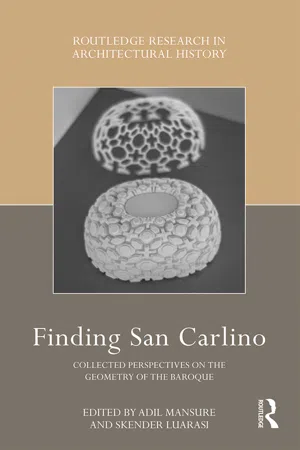
Finding San Carlino
Collected Perspectives on the Geometry of the Baroque
- 184 pages
- English
- ePUB (mobile friendly)
- Available on iOS & Android
Finding San Carlino
Collected Perspectives on the Geometry of the Baroque
About this book
The church of San Carlo alle Quattro Fontane, also called San Carlino, is an architectural artefact that continues to attract numerous hypotheses and geometric analyses attempting to explain its form and meaning. Numerous investigations have attempted to reveal its underlying geometrical principles, without, however, reaching a consensus. Finding San Carlino presents an edited collection of perspectives on Borromini's famous Baroque church from a range of established and emerging scholars in architectural history and theory, including Werner Oechslin, Karsten Harries, Michael Hill and Lauren Jacobi amongst others.
This book offers the reader different means of engaging with, enjoying and articulating San Carlino's complexity, non-consensus and ambiguity. It is precisely such a unique disposition that motivates this book to explore multiple modes of architectural enquiry and delve into a series of theoretical and historiographical questions such as: why was Borromini not able to post-rationalize his architecture with his drawings? What is San Carlino's exemplary value, and why does it continually engender exegetical and hermeneutic desire? What is the role of geometry in architecture, in history and today?
Written for researchers, scholars and postgraduate students in architectural history and theory, the book uses San Carlino as an enigmatic centering point for a set of significant contemporary voices to explore new modes of confrontation and comparison.
Frequently asked questions
- Essential is ideal for learners and professionals who enjoy exploring a wide range of subjects. Access the Essential Library with 800,000+ trusted titles and best-sellers across business, personal growth, and the humanities. Includes unlimited reading time and Standard Read Aloud voice.
- Complete: Perfect for advanced learners and researchers needing full, unrestricted access. Unlock 1.4M+ books across hundreds of subjects, including academic and specialized titles. The Complete Plan also includes advanced features like Premium Read Aloud and Research Assistant.
Please note we cannot support devices running on iOS 13 and Android 7 or earlier. Learn more about using the app.
Information
1
On Borromini’s drawings and “practical geometry”
I. Ποίησις/inventio and its richness and differentiation embodied in (geometrical) drawing
II. The assistance of geometry: mediation and the “mixing” of abstract and sensory signs
Table of contents
- Cover
- Half Title
- Series Page
- Title
- Copyright
- Contents
- List of illustrations
- List of contributors
- Acknowledgments
- Preface
- Foreword
- Introduction: after San Carlino
- 1 On Borromini’s drawings and “practical geometry”: voleva dentro una cosa cavare un’altra, e nell’altra l’altra senza fi nire mai
- 2 Toggling through San Carlino: a speculative inquiry into the geometry and process in San Carlino and its interpretations in history
- 3 The deep structure of San Carlino
- 4 Architecture, geometry, and the sacred
- 5 Baroque constructive geometry? Borromini’s design for the elevation at San Carlino
- 6 From string to volume
- 7 A part of the whole: the Crucifix chapel in San Carlo alle Quattro Fontane
- 8 San Carlino as Surface
- 9 The Xenophora Principle: finding San Carlino … in a shell
- Conclusion: the future pasts of San Carlino
- Bibliography
- Index